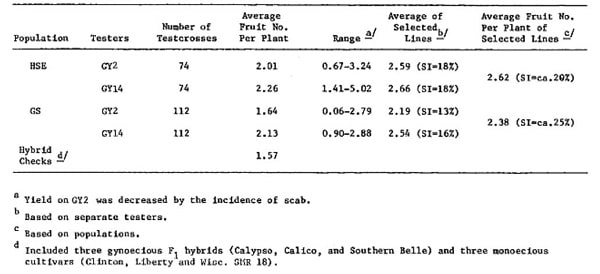Cucurbit Genetics Cooperative Report 6:18-19 (article 9) 1983
K. Lertrat and R. L. Lower
University of Wisconsin, Madison, WI 53706
Low fruit number per plant (i.e. fruit yield) is the major yield-limiting factor of all existing pickling cucumber cultivars for a once-over mechanical harvesting system. Fruit yield average over three years under commercial field conditions is, about 2.5 fruits per plant per harvest (2). Research efforts focused on the development of new hybrids with higher fruit yield are underway. Increased fruit number per plant leads to higher yield and increases the feasibility of a mechanical harvesting system.
A pickling cucumber population improvement program has been conducted at the University of Wisconsin since 1979. Two divergent populations (HSE=hardwickii semi-exotic population and GS=gynoecious synthetic population) were developed to initiate selection for increased fruit number per plant. Nienhuis (3) evaluated 3 cycles of S1 progeny selection and found that in all populations (HSE, GS, and HSE x GS)1the average rates of gain were highly significant.
This population improvement program has continued and utilizes recurrent selection for specific combining ability (RSC) with gynoecious inbred lines as testers. This procedure has been effective in improving both specific and general combining ability in other crops (1). Also, as suggested by Smith et al. (4), this procedure should provide an efficient means of selection (,uniformity of fruit set) and lead directly to development of hybrids.
One cycle of RSC using GY2 and GY14. as inbred testers was completed in 1982. Average fruit yield (at optimum harvest time) for GY2 and GY14 testcrosses of HSE and GS were 2.01, 2.26, 1.64, and 2.13 fruit per plant, respectively (Table 1). Testcross yields were higher than hybrid checks (1.57 fruit per plant). The top 26 lines (HSE) (SI=ca. 25%), 13 lines from testcrosses with both testers, with-an average fruit yield of 2.62 and top 33 lines (GS) (SI=ca. 20%), 15 lines from testcrosses with GY2 and 18 lines from testcrosses with GY14, with an average fruit yield of 2.38 were selected for further population improvement.
Table 1. Summary of one cycle of recurrent selection for specific combining ability for increased fruit yield in two divergent populations, HSE and GS, using GY2 and GY14 as testers.

Literature Cited
- Hallauer, A. R. 1975. Relation of gene action and type of tester in maize breeding procedures. Proc. Annu. Corn Sorghum Res. Conf. 30:150–165.
- Lower, R. L. 1983. Unpublished data.
- Nienhuis, J. 1982. Response to different selection procedures for increased fruit yield in two pickling cucumber populations. Ph.D. Thesis. University of Wisconsin-Madison.
- Smith, O. S., R. L. Lower and R. H. Moll. 1978. Estimates of heritabilities and variance components in pickling cucumber. J. Amer. Soc. Hort. Sci. 103:222–225.